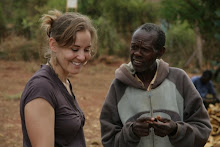
I joined the same guys and organizations from our visit to Mathaato a few weeks ago, along with Lars and our friend Sandra who is an up and coming designer here in Kenya. We followed the motorbike in the picture above along the edge of the airport, through uneven terrain as we left the paved roads of Nairobi. We knew we were close when we began to encounter the trademark goat and cow herds of the Masai.

Residents of Olmaa suggest there are over a 1,000 Masai living in the village. Having visited and driven through the central part of town, we're sure there are more. In the area we visited, many of the children (and believe me, there were many!) are the brood of the local chief - who with his cattle has secured the land for his family's use (rumor has it he has 19 wives total). Apparently it's protected space due to its proximity to the airport - formal development would be prohibited.

We visited with a number of Olmaa's women who create traditional Masai bead work. Both Sandra and I are interested in commissioning some custom pieces, so it was a great opportunity to see their creations and learn about the community.

Like so many of my experiences here, today's visit was special for the opportunity to bear witness to the existence of so many people living (literally and figuratively) on the fringe of society. In Kenya, districts are represented by MPs, and to move forward in government you don't relinquish your role as an MP - thus both President Kibaki and the Prime Minister Odinga (following the advent of the coalition government after the disputed elections of 2007) still have active constituencies. Olmaa happens to be in Odinga's constituency, and yet he apparently doesn't know this group even exists (thus leaving their land safe, for now).

We didn't bring anything for this community, and they didn't ask us for much. They did request help in supplying their one Pre-k through 4th grade school with books. Apparently one of the kids we met was told not to come to school anymore until she had a copy of the English reader they use in class, and the village lacks the funds to outfit their kids with the required materials.

Armstrong, the Executive Director of one of the orgs that has shared these visits with us (for the life of me I can't get their names straight!) first learned of Olmaa when one of the girls from the village was recommended by a family member for the boarding school he runs. Her family can visit her, but she won't return to the village until her schooling is done, as the school wants to ensure her proper nutrition and continued education, as well as protect her from the female circumcision that is still practiced in the most traditional of Masai communities.

We left the village in the late afternoon after meeting one of its eldest members (we were told she's 150!). You can see a few more pics of today's visit here. I'll leave you with this one, a perfect representation of Nairobi traffic. We had eight people in the car going back, and sat for quite some time in bumper to bumper traffic. That guy having a chat outside of the car? That's our driver.



No comments:
Post a Comment